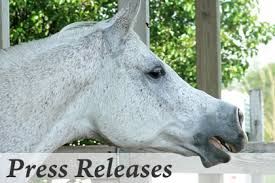Q&A: Managing Arthritis in Horses
- Posted by Press Release
Understanding horse arthritis treatment and horse joint health
Thoroughbred mare, Tiz Cha Cha, never traveled balanced to the left. When she would collect in dressage or frame over a jump, she would become aggressive with ears pinned, relentlessly throw her head or rear up dangerously. Her behavior was chalked up to being a “hot” off-the-track Thoroughbred; however, a series of X-rays revealed what the human eye could not see — a C1 fracture of the vertebrae, nearest the poll, causing her significant pain from bone-on-bone contact and arthritis.
What is equine osteoarthritis or degenerative joint disease?
Equine degenerative joint disease (DJD) is often referred to as equine osteoarthritis (OA). This chronic disease causes degeneration of the joints and results in pain, inflammation and reduced flexibility. Any joint in a horse’s body can be affected, and all horses regardless of age, breed or discipline can be impacted. It is estimated that OA is responsible for up to 60 percent of all lameness in horses.
Do different equine sports affect specific joints?
Although any horse in any discipline can be affected by OA, there are common themes and joint problems that occur in the varying equine sports. Such as for cutting and reining horses, who have greater impact on their hocks and stifles causing them to have heightened OA risk to these joints. Additionally, hunter jumpers are more likely to have front limb lameness in the coffin or fetlock joints. Any joint that is more significantly used on a horse increases its likelihood for developing OA.
What causes arthritis in horses?
- Trauma to the joint
- Conformation
- Age
- Improper shoeing
What are the signs of arthritis in horses?
- Limping or lameness in single or multiple joints
- Warm-to-the-touch, swollen or painful joints
- Reluctance or difficulty standing, walking, trotting or cantering
- Stiffness or decreased movement of joints
What can I do if I think my horse has arthritis?
If you suspect your horse is suffering from joint pain, request an examination from your veterinarian. Your veterinarian can perform a lameness evaluation, during which he or she may also recommend other diagnostics for a clear diagnosis. Should OA be diagnosed, ask for information about treatment for the pain and inflammation associated with osteoarthritis
Create a free account with TheHorse.com to view this content.
TheHorse.com is home to thousands of free articles about horse health care. In order to access some of our exclusive free content, you must be signed into TheHorse.com.
Start your free account today!
Already have an account?
and continue reading.
Written by:
Press Release
Related Articles
Stay on top of the most recent Horse Health news with










